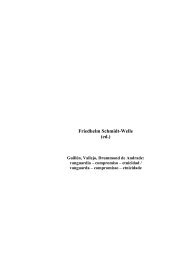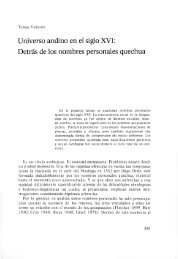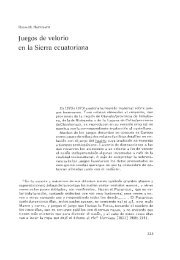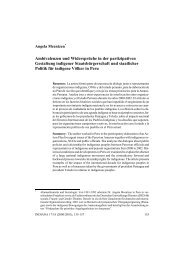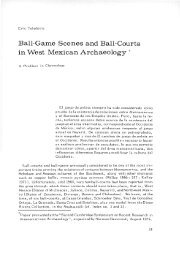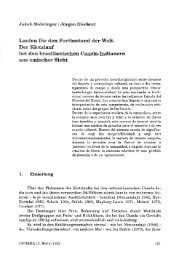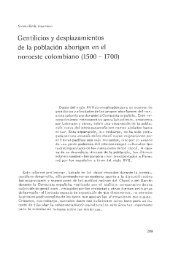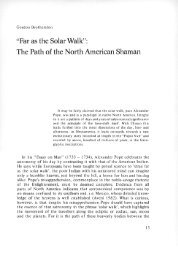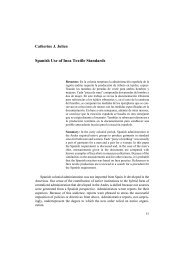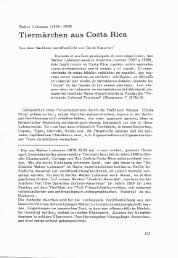Time and Script in Ancient Mesoamerica
Time and Script in Ancient Mesoamerica
Time and Script in Ancient Mesoamerica
You also want an ePaper? Increase the reach of your titles
YUMPU automatically turns print PDFs into web optimized ePapers that Google loves.
Gordon Brotherston<br />
<strong>Time</strong> <strong>and</strong> <strong>Script</strong><br />
<strong>in</strong> <strong>Ancient</strong> <strong>Mesoamerica</strong><br />
En <strong>Mesoamerica</strong> se encuentran la única escritura<br />
regularizada del trópico del planeta (la de los maya),<br />
además de unos sistemas calendáricos notablemente<br />
complicados. Dada la íntima conexión entre los dos<br />
fenómenos, se <strong>in</strong>tenta demostrar que el factor decisivo<br />
en el sistema de los maya, en cuanto a escritura<br />
y calendario (el 'Long Count' de la época clásica),<br />
fue la ecuación de una entidad aritmética con el día solar,<br />
ecuación que falta en otras culturas mesoamericanas<br />
(la tolteca, la mixteca) donde se empleaba el<br />
sistema de 'cargadores de años' ('yearbearers') y de<br />
un ario solar de 365 'días' que no podían ser siempre<br />
iguales. De ahí se sugieren unos paralelos entre esta<br />
aritmética rudimentaria, pero tan esencial como fértil<br />
en consecuencias lógicas, y la gramática de la escritura<br />
jeroglífica de los maya.<br />
To say that ancient <strong>Mesoamerica</strong>ns were preoccupied with time hardly runs<br />
the risk of controversy. Even modest commentaries on their culture abound<br />
with references to their obsession with it, to the hypnosis it exerted on them,<br />
to their dependence on it as a prime reality. Now this focus of ours on their<br />
'obsession' co<strong>in</strong>cides with a focus of modern philosophy generally, J.R. Lucas's<br />
recent "Treatise on <strong>Time</strong> <strong>and</strong> Space" opens withthe statement that the<br />
former is 'more fundamental' than the latter. For their part, Toulm<strong>in</strong> <strong>and</strong><br />
Goodfield have recorded the Western"Discovery of <strong>Time</strong>" which culm<strong>in</strong>ates
<strong>in</strong> post-E<strong>in</strong>ste<strong>in</strong> cosmologies. This co<strong>in</strong>cidence of focus is unfortunate <strong>in</strong>sofar<br />
as it can obscure the difference between a 'fourth' <strong>and</strong> a first dimension.<br />
Whatever logical statements may or may not be made about time <strong>and</strong> space<br />
as universal concepts, it is clear that <strong>in</strong> the Western tradition scientific measurement<br />
of the one has been <strong>in</strong>timately related to that of the other. The sexigesimal<br />
system of m<strong>in</strong>utes <strong>and</strong> seconds which the Babylonians <strong>in</strong>itially derived<br />
from celestial co-ord<strong>in</strong>ates still has a temporal as well as a spatial<br />
application. Similarly, much of Lucas's flourish <strong>in</strong> favour of time would be<br />
lost if geometry had never existed. For the ancient <strong>Mesoamerica</strong>ns, however,<br />
time, <strong>and</strong> time only, was scientifically everyth<strong>in</strong>g from the start. Elsewhere<br />
(Brotherston <strong>and</strong> Ades 1975; Brotherston 1975a) we have shown that as<br />
the only tropical astronomers on the planet they had no verifiable card<strong>in</strong>al<br />
po<strong>in</strong>ts, <strong>and</strong> that their cosmos lacked reliable spatial co-ord<strong>in</strong>ates, <strong>and</strong> certa<strong>in</strong>ly<br />
all geometry. Indeed, the notion of 'po<strong>in</strong>ts' <strong>and</strong> 'l<strong>in</strong>es or spaces between'<br />
. <strong>in</strong> the strict sense, was foreign to them. Cassirer (1964: 107), for<br />
example, derives the Old World concept of spatial or temporal <strong>in</strong>terval from<br />
the <strong>in</strong>tersect<strong>in</strong>g of the sun's east-west l<strong>in</strong>e by that 'perpendicular runn<strong>in</strong>g<br />
from north to south' which the <strong>Mesoamerica</strong>ns never drew.<br />
Hav<strong>in</strong>g no place to st<strong>and</strong> (Archimedes: 'Give me somewhere to st<strong>and</strong> <strong>and</strong><br />
I will move the universe'), the <strong>Mesoamerica</strong>ns had other'grounds' for knowledge<br />
<strong>and</strong> an epistemology that was restricted to their one 'dimension', the s<strong>in</strong>gle,<br />
temporal east-west direction. Hence that enormous concentration of<br />
thought <strong>in</strong>to time. While undivided <strong>and</strong> unmeasured <strong>in</strong> our terms, time was<br />
however systematically expressed <strong>in</strong> the notations of calendar arithmetic<br />
<strong>and</strong> astronomy. As a result, what might appear to us to be casual or r<strong>and</strong>om<br />
'variations' <strong>in</strong> these notations, as local or idiosyncratic 'usages' with<strong>in</strong><strong>Mesoamerica</strong>,<br />
will <strong>in</strong> fact sooner reveal logical dist<strong>in</strong>ctions, the consequences<br />
of which we may explore.<br />
Our advantage <strong>in</strong> this matter is that such 'variations' may be very f<strong>in</strong>ely<br />
gauged because certa<strong>in</strong> methods of reckon<strong>in</strong>g time, notably by means of<br />
the 'Calendar Round' of 52 years, were used by many different peoples <strong>in</strong><br />
<strong>Mesoamerica</strong> <strong>and</strong> can be traced back well <strong>in</strong>to the first milennium B.C. Our<br />
disadvantage is that pre-Columbian source material is most unevenly spread<br />
between these peoples, <strong>and</strong> that very scanty evidence rema<strong>in</strong>s of the nature<br />
of the earliest calendars, of the Olmec, the Zapotee, <strong>and</strong> the pre-classic<br />
Maya. Thus, while this enquiry by no means pretends to cover all known conventions<br />
of time reckon<strong>in</strong>g <strong>in</strong> the <strong>Mesoamerica</strong>n area, the pre-Toltec calendar<br />
of the Southern Zapotee, for example, or the Mava 'Short Count',<br />
it does seek to place <strong>and</strong> contrast conventions which are apparently similar.<br />
The ma<strong>in</strong> reason for do<strong>in</strong>g this is to exam<strong>in</strong>e the connection between time<br />
record<strong>in</strong>g <strong>and</strong> script, which Barthel (1968: 283) has called 'noth<strong>in</strong>g less than<br />
def<strong>in</strong><strong>in</strong>g criterion of <strong>Ancient</strong> Mexico'. The approach may perhaps be premature,<br />
<strong>in</strong> view of the grow<strong>in</strong>g discoveries of 'proto-scripts' at Teotihuacan,<br />
10
Xochicalco, Monte Alban <strong>and</strong> the Olmec gulf coast sites (Kubier 1962: 37-41).<br />
On the other h<strong>and</strong> enough evidence is available for some sort of comparative<br />
analysis of 'essential' forms. We attempt to relate a modest read<strong>in</strong>g of primary<br />
sources (<strong>in</strong> facsimile <strong>and</strong> photographic form) (1) to fundamental <strong>in</strong>terpretations<br />
by Seler (1902), Thompson (I960, 1962 <strong>and</strong> 1965), Caso (1965 <strong>and</strong><br />
1965 a), Nowotny (1961), Barthel (1968), Satterthw^aite (1965), <strong>and</strong> others.<br />
It is hardly anticipat<strong>in</strong>g the ma<strong>in</strong> argument to say that the most obvious<br />
difference between <strong>Mesoamerica</strong>n methods of time reckon<strong>in</strong>g is between those<br />
which used Long Count arithmetic <strong>and</strong> those which didn't.The Long Count,<br />
with its attention to units of time <strong>and</strong> its place notation, seems <strong>in</strong>fact to have<br />
been restricted to the Maya <strong>and</strong> the Gulf Coast Olmec, even though the peoples<br />
surround<strong>in</strong>g them can hardly have failed to notice or underst<strong>and</strong> it. Nov/ it is<br />
precisely the Maya (s<strong>in</strong>ce almost noth<strong>in</strong>g rema<strong>in</strong>s of Olmec writ<strong>in</strong>g) who may<br />
be said to have produced the only script worthy of the name not just <strong>in</strong> America,<br />
but <strong>in</strong> the tropical zone of the planet (Dir<strong>in</strong>ger 1968). This exclusivedevelopment<br />
of arithmetic <strong>and</strong> script was far from r<strong>and</strong>om <strong>and</strong> po<strong>in</strong>ts to important<br />
connections between the two <strong>in</strong> tropical epistemology. In order to suggest<br />
how this may be so we should look at what reckon<strong>in</strong>g <strong>and</strong> not reckon<strong>in</strong>g<br />
with the Long Count meant <strong>in</strong> practice. In other words we should look aga<strong>in</strong><br />
at the <strong>Mesoamerica</strong>n calendar as it existed without Long Count arithmetic.<br />
As social time counts, calendars may usually be described as cont<strong>in</strong>uous<br />
or discont<strong>in</strong>uous; or aga<strong>in</strong>, as more, or less consistent with astronomical<br />
time. Discont<strong>in</strong>uous calendars present no problem. A run of dates,of civil,<br />
agricultural or religious significance, is <strong>in</strong>itiated by some astronomical event,<br />
lunar or solar or planetary or stellar or some comb<strong>in</strong>ations of these,<br />
or by a sign of seasonal change like the Nile Flood. But precisely because<br />
such a run or series does not attempt to fill time it need not account for or<br />
be responsible to astronomical cycles <strong>in</strong> their entirety, these be<strong>in</strong>g far from<br />
easy to match with each other, lunations expressed as solar days be<strong>in</strong>g a notorious<br />
case. Conversely, astronomical time counts may <strong>in</strong> themselves become<br />
extremely detailed <strong>and</strong> exact, as they became <strong>in</strong> Ch<strong>in</strong>a <strong>and</strong> Mesopotamia,<br />
before be<strong>in</strong>g <strong>in</strong>tegrated <strong>in</strong>to a social system, that is, before be<strong>in</strong>g made<br />
usable <strong>in</strong> day-to-day terms. In the West, Ptolemy's 'Canon' of Babylonian<br />
astronomy was not put to social <strong>and</strong> historical use <strong>in</strong> this sense before 400<br />
A.D. (Toulm<strong>in</strong> <strong>and</strong> Goodfield 1965: 28-29).<br />
An expression for 'now ' like '2.15 p.m. Monday 30th December 1974 ' reveals<br />
the compt ite nature of our everyday descriptions of time, Monday,<br />
logically a redundant term, like December (s<strong>in</strong>ce 30th of 12th <strong>in</strong> 1974 = 364th)<br />
belong to rounds of names which are rooted <strong>in</strong> myth, <strong>in</strong> the case of the month,<br />
some (January) deeper than others (December). Named weekdays are used<br />
as a memorable sequence <strong>and</strong> for their qualities as k<strong>in</strong>ds of days among given<br />
societies, social classes <strong>and</strong> <strong>in</strong>dividuals, these qualities deriv<strong>in</strong>g <strong>in</strong> part<br />
from usage, but also from residually <strong>in</strong>herent force. It is of course precisely<br />
this force, which itself has noth<strong>in</strong>g to do withastronomical time, which revolutionary<br />
calendars have tried to counteract. Although it has this charac-<br />
11
ter,<strong>and</strong> although it proceeds <strong>in</strong> unbroken sequence regardless of anyth<strong>in</strong>g<br />
exterior to it, the -.veek nonetheless has been long fixed <strong>in</strong> time as a set number<br />
of solar days.As a lunar survival, the month has lost all loyalty to that<br />
orig<strong>in</strong> <strong>and</strong> also yields to solar time via the leap year. And it was noth<strong>in</strong>g but<br />
the movement of the sun through north-south meridians which gave the yet<br />
more exact <strong>and</strong> completed solar time of 2.15 p. m, We may then say that the basic,<br />
non-redundant elements <strong>in</strong> our usual description of 'the time', division<br />
of day,day <strong>and</strong> year,are not just astronomical butsolar <strong>in</strong>orig<strong>in</strong>. Of course<br />
the very calculations which led to early estimates of the length of the solar<br />
year also soon disclosed a discrepancy between it <strong>and</strong> the sidereal year<br />
(due to the effect of precession), just as they later allowed for accurate<br />
measurement of the difference between solar <strong>and</strong> mechanical time (at the<br />
time mentioned solar anomaly means that the clock is <strong>in</strong> practice some m<strong>in</strong>utes<br />
at variance with the hour <strong>and</strong> m<strong>in</strong>utes 'post meridiam'). But the generalization<br />
holds (see Neugebauer 1951).<br />
In turn<strong>in</strong>g to <strong>Mesoamerica</strong> we may ask, to what extent <strong>and</strong> how was time<br />
reckoned <strong>in</strong> astronomical terms, <strong>and</strong> when it was, <strong>in</strong> terms of what k<strong>in</strong>d of<br />
astronomy. If the argument of two previous papers is correct (Brotherston<br />
<strong>and</strong> Ades 1975; Brotherston 1975 a) we should not necessarily expect to f<strong>in</strong>d<br />
years, days <strong>and</strong> division of days like ours. All the evidence suggests that<br />
the north-south, midnight-midday meridians, or their geometrical equivalents,<br />
by which these time units were determ<strong>in</strong>ed were unknown <strong>in</strong> <strong>Mesoamerica</strong>.<br />
THE TWENTY SIGNS, THE SACRED AND THE CALENDAR ROUNDS<br />
A common feature of almost all <strong>Mesoamerica</strong>n calendars was twenty signs.<br />
Although the most frequent use of these signs was calendrical with <strong>and</strong> without<br />
the Long Count, as a body or corpus they may be seen to have had <strong>in</strong>herently<br />
noth<strong>in</strong>g to do with time. Their particular orig<strong>in</strong>s are still <strong>in</strong> part<br />
obscure. But there can be no doubt that they manifest mythic forces <strong>and</strong> elements<br />
like W<strong>in</strong>d, Snake, Death, Water, Dog, Fl<strong>in</strong>t, Ra<strong>in</strong>storm <strong>and</strong> so on.<br />
When the orig<strong>in</strong> is celestial, Venus for example, the sign is no more bound<br />
to the time of that body than Monday is to the moon. Beyond the fact that it<br />
is not temporal, the detail of these orig<strong>in</strong>s need not concern us here.<br />
More important is the consistency that the twenty signs display as a sequence<br />
of mean<strong>in</strong>gs, <strong>in</strong> quite varied cultures <strong>and</strong> languages. Though the pre-<br />
Toltec signs at Monte Alban diverge somewhat, there is a marked coherence<br />
elsewhere, among the Maya from pre-Classic times, the Mixtees, the Aztecs<br />
<strong>and</strong> other Nahua groups, <strong>and</strong> peoples yet further afield like the Otomi.<br />
Equivalence of the set, between one culture <strong>and</strong> another, is usually of concept,<br />
quite different words be<strong>in</strong>g used locally for the same or a recognizably<br />
related sign. But it may also be phonetic, the sound of a given sign<br />
suggest<strong>in</strong>g a similar but more familiar mean<strong>in</strong>g <strong>and</strong> sign <strong>in</strong> another language,<br />
The sets of signs vary, then, accord<strong>in</strong>g to time <strong>and</strong> place; but not<br />
<strong>in</strong> such a way as to obliterate their existence as a Patrimonium commune<br />
(Seler 1902: 503). Both <strong>in</strong> age <strong>and</strong> range of use they appear as a primary<br />
order<strong>in</strong>g of <strong>Mesoamerica</strong>n reality : a sequence of shapes that was translatable<br />
but <strong>in</strong> any one case <strong>in</strong>itially <strong>in</strong>dispensable.<br />
12
The fact that the signs amount to twenty means not so much derivation<br />
from the total of man's digits as belief <strong>in</strong> that quantity as a body, the prime<br />
entity. In Yucatec the signs are collectively called the u<strong>in</strong>al. a close<br />
cognate of u<strong>in</strong>ic. man, two words which are actually identical <strong>in</strong> other Maya<br />
languages. In the Book of Chilam Balam of Chumayel (pp. 60-61) the<br />
creation of the u<strong>in</strong>al is not a cumulative process, for its existence precedes<br />
<strong>and</strong> is presupposed by that of its parts. (This may appear the more<br />
remarkable when we consider, as we do below, that the u<strong>in</strong>al of the Maya<br />
had undergone more thorough arithmetical analysis than its counterpart<br />
elsewhere). In the documents of other cultures, pre- <strong>and</strong> post-Conquest,<br />
we f<strong>in</strong>d arrangements of the signs around <strong>and</strong> fused with s<strong>in</strong>gle or tw<strong>in</strong> bodies,<br />
of gods, animals <strong>and</strong> men (Laud: 2; Borgia: 17; Vaticanus B: 96;Mexicanus:<br />
XII; Fejérváry: 1 (see Nowotny 1961: 214-216, <strong>and</strong>fig. 1-2),) .<br />
However, <strong>in</strong> contrast to similar arrangements <strong>in</strong> European astrology , of<br />
anatomy <strong>in</strong> relation to the signs of the zodiac for example, the position of<br />
the <strong>Mesoamerica</strong>n signs <strong>in</strong> these draw<strong>in</strong>gs is not constant. In other words<br />
they are subject to no law above their own, this law be<strong>in</strong>g one of sequence.<br />
To this extent the logic of the whole body of signs is temporal rather than<br />
spatial, s<strong>in</strong>ce they have no fixed place except next to each other, serially.<br />
This quality of the twenty signs taken together makes them admirably suitable<br />
for calendrical use, <strong>and</strong> may <strong>in</strong>deed have been assured by such use.<br />
At the same time we should be alert to their <strong>in</strong>dependent existence, with<br />
implicit <strong>and</strong> immutable order, <strong>and</strong> to their frequent use, right up to the<br />
Conquest, <strong>in</strong>dependently of astronomical time. Caso (1956: 956) has discussed<br />
their purely'religious <strong>and</strong> magical significance ' on bone carv<strong>in</strong>gs at<br />
Monte Alban (Tomb 7), a significance most thoroughly v<strong>in</strong>dicated <strong>in</strong> general<br />
by Nowotny (1961: 206).<br />
The temporal logic of the signs was exploited <strong>in</strong> various ways. Among the<br />
Aztecs for example, they identified the succession of epochs or 'suns'of the<br />
world, past <strong>and</strong> present. By far their commonest function, however, was<br />
together with numbers, from 1 to 13, to produce 260 moments or dist<strong>in</strong>ct<br />
comb<strong>in</strong>ations, generally called the 'Sacred Round' (the tonalpohualli of the<br />
Aztecs). To know the exact relationship of this round to astronomical time,<br />
of year or day, once aga<strong>in</strong> <strong>in</strong> non-Long Count systems, is by no means easy.<br />
Arrangements of the Sacred Round <strong>in</strong> the codices, where it rema<strong>in</strong>s uncorrelated<br />
with any recognizable temporal period, do not of themselves<br />
specify what lengths of time were <strong>in</strong>volved, if <strong>in</strong>deed unit lengths were <strong>in</strong>volved<br />
at all. Sooner than time measurement we f<strong>in</strong>d a reflexive concern<br />
with <strong>in</strong>ternal group<strong>in</strong>g: four lots of 65, five lots of 52, <strong>and</strong> so on, the patterns<br />
between moments be<strong>in</strong>g all-important. Given what we can deduce about<br />
the signs as a primary entity, <strong>and</strong> that the numbers. 1 to 13 were themselves<br />
apparently thought of as div<strong>in</strong>e rather thanunitary, this k<strong>in</strong>d of selfsufficiency<br />
need not be surpris<strong>in</strong>g. At least, as div<strong>in</strong>atory documents of<br />
professionals <strong>in</strong> the mantic <strong>and</strong> ritual arts, they would have had a raison<br />
d'etre from their <strong>in</strong>herent qualities alone, from their own immanent magic.<br />
For the concern was clearly with div<strong>in</strong>e associations through 'regents' <strong>and</strong><br />
13
emblems, <strong>and</strong> the propitiousness (good, bad or <strong>in</strong>different) of given moments,<br />
alone or <strong>in</strong> sequences, <strong>and</strong> <strong>in</strong> vary<strong>in</strong>g general contexts. How these<br />
mean<strong>in</strong>gs were <strong>in</strong>terpreted, as from cards <strong>in</strong> the pack, <strong>and</strong> were applied to<br />
present time rema<strong>in</strong>s another matter. When we see a fire quenched by water<br />
at the moment '8 Water' (Laud: 25) <strong>in</strong> a series deal<strong>in</strong>g with funeral rites<br />
we realize that the fix<strong>in</strong>g of the moment depends on a logic other than that<br />
of astronomical time. For the same reason it cannot be too strongly emphasized<br />
that the mantic art of the Sacred Round, <strong>in</strong> the read<strong>in</strong>g of dreams<br />
<strong>and</strong> omens or the div<strong>in</strong>ation of fate, was not astrological <strong>and</strong> had no such<br />
dependence on exterior space <strong>and</strong> time (a dist<strong>in</strong>ction blurred more generally<br />
by Cassirer (1964: 93)). This view of the Sacred Round is explicitly<br />
confirmed by Mol<strong>in</strong>a's Vocabulario. Though tonal is associated with 'sun'<br />
<strong>and</strong> poa means 'to count', tonalpohualli. the Sacred Round, is said to be<br />
someth<strong>in</strong>g by which signs <strong>and</strong> dreams are div<strong>in</strong>ed; tonalpoa means 'sacar<br />
las fiestas' or decide on the actual date of a particular festival, the implication<br />
be<strong>in</strong>g that such dates were not obvious from astronomical time alone.<br />
Arrangements of the Sacred Round may be l<strong>in</strong>ear or tabular, abbreviated<br />
or <strong>in</strong> extenso, partial or whole. But only when the Sacred Round is<br />
comb<strong>in</strong>ed with a known time period may we guess at the actual temporal<br />
value of its moments.<br />
In calendrical (as opposed to mantic) use, the Sacred Round was most<br />
commonly comb<strong>in</strong>ed with the solar year, to produce the Calendar Round of<br />
52 years, the largest time period normally available to cultures which did<br />
not employ the Long Count. For these calendrical purposes the solar year<br />
vvas expressed as 365 'days', 365 be<strong>in</strong>g <strong>in</strong> fact nearest to the number of<br />
whole days <strong>in</strong> the year. This figure was fixed upon very early, for the Calendar<br />
Round also belongs to the pre-Classic stages of <strong>Mesoamerica</strong>n cultures<br />
(Satterthwaite 1965: 606). It could have been decided on as a result<br />
of a tally of sunrises between two annual heliacal ris<strong>in</strong>gs of a star, or<br />
between a solstitial or other sunrise or set position on the horizon (Merrill<br />
1945), these methods be<strong>in</strong>g widely used for the purposes of adjustment <strong>in</strong><br />
later stages of the culture. Which br<strong>in</strong>gs us to the crucial realization that<br />
the very methods which produced a figure as'close' as 365 must have shown<br />
from the start that it was only approximate <strong>in</strong> terms of equal days. In other<br />
words, the decision to <strong>in</strong>tegrate the Sacred Round with the solar year (every<br />
365th of the cont<strong>in</strong>u<strong>in</strong>g succession of 260 'days', with its numeral <strong>and</strong><br />
sign, was specified as a 'year bearer', to give 18,980, or 365x52 fourelement<br />
comb<strong>in</strong>ations) must have been made with the full awareness that<br />
these comb<strong>in</strong>ations, as days, would be mostly, but not always, equal to<br />
periods from sunrise to sunrise (or sunset to sunset). So that while we may<br />
fairly speak of the 52 years of the Calendar Round, be they sidereal or solar,<br />
we hesitate to identify its days as ours (of which more like 18,993 elapse<br />
over 52 years).<br />
What constituted a day <strong>in</strong> anyth<strong>in</strong>g but Long Count arithmetic is <strong>in</strong> any<br />
case notoriously uncerta<strong>in</strong>. We don't know when it was supposed to beg<strong>in</strong>or<br />
end, or of its relationship to the night period, which apparently had a count<br />
14
to itself. <strong>Mesoamerica</strong>n astronomy was not of the k<strong>in</strong>d to have led to <strong>in</strong>ternal<br />
measurement of day or night, or to the formal description of them <strong>in</strong><br />
equal or equivalent periods of 'hours'. Aga<strong>in</strong>, words for day are sometimes<br />
related to 'sun' (as <strong>in</strong> the Zapoteo chii ), but this sun referred also<br />
to world ages (as among the Aztecs), <strong>and</strong> the solar sign conventionally denoted<br />
the year <strong>in</strong> the Mixtee codices. By contrast the year is firm <strong>in</strong> vocabulary<br />
<strong>and</strong> design, as is the Calendar Round, always equivalent to itself.<br />
Because 365 is divisible by 20 with a rema<strong>in</strong>der of 5, only 4 of the twenty<br />
signs, each five positions away from the next, could serve as year bearers,<br />
the 52 years of the Calendar Round be<strong>in</strong>g a product of these four signs <strong>and</strong><br />
the 13 numerals. Now <strong>in</strong> the codices these signs are shown to be <strong>in</strong>terchangeable<br />
parts of set, by be<strong>in</strong>g encircled or put <strong>in</strong> boxes, or by be<strong>in</strong>g attached<br />
the solar sign mentioned above (fig. 3). Formally, they are proposed as the<br />
'same sort of th<strong>in</strong>g', <strong>in</strong> a way unavailable to other 'day' dates <strong>in</strong> calendrical<br />
use, a po<strong>in</strong>t of enormous consequence for our discussion below of the Long<br />
Count day. Further, like the Calendar Round or xiuhmolpilli the year could<br />
be denoted abstractly as a concept, divorced from any particular date. This<br />
appears not to have happened with the 'day' <strong>in</strong> pre-Conquest times <strong>and</strong> once<br />
aga<strong>in</strong> the contrast with Long Count practice is crucial.<br />
In several pre-Columbian contexts the year bearer signs are associated<br />
with the likely means of how their position <strong>in</strong> astronomical time was determ<strong>in</strong>ed.<br />
The diagonals of Fejérváry page 1 (fig.l) may well be understood to<br />
be solstitial. The New Year ceremonies <strong>in</strong> the Madrid page 34, show an eye<br />
connected by a spanner-like device to one of a circle of stars, a possible depiction<br />
of an annual heliacal ris<strong>in</strong>g. Yet other possible devices are suggested<br />
<strong>in</strong> the Mixtee codices, an eye between crossed sticks, for example, used to<br />
discover a star's altitude, ad hoc. Admittedly much of the detail of the adjustments<br />
of astronomical time to the calendar (it is better understood this<br />
rather than the other way round) rema<strong>in</strong>s obscure ; but there can be little<br />
doubt that they are as old as the Calendar Round itself. All available evidence<br />
<strong>in</strong>dicates that from the moment of the first correlation of the Sacred<br />
Round with 365 'days' up to the present, the agricultural <strong>and</strong> religious years<br />
ofpeoles us<strong>in</strong>g only that reckon<strong>in</strong>g have not got seriously out of l<strong>in</strong>e with<br />
astronomical time.<br />
For such agricultural <strong>and</strong> religious purposes the year of 365 'days' was<br />
divided up <strong>in</strong>to 18 months of 20 <strong>and</strong> 1 month of 5 such days. The names <strong>and</strong><br />
etymologies of these months, by contrast with those of the twenty signs, vary<br />
extremely from group to group, as does their particular fix<strong>in</strong>g <strong>in</strong> astronomical<br />
time, suggest<strong>in</strong>g no conceptual norm. The enormous differences <strong>in</strong> ra<strong>in</strong>fall<br />
patterns <strong>and</strong> hence agricultural practice from area to another, <strong>and</strong>,above<br />
all, the undifferentiat<strong>in</strong>g course of the sun to north <strong>and</strong> south of the zenith,<br />
meant noth<strong>in</strong>g like the 'seasons' of the temperate zones developed as general<br />
concepts. Mol<strong>in</strong>a's "Vocabulario" lists summer <strong>and</strong> autumn <strong>and</strong> w<strong>in</strong>ter<br />
as tonalco. while wet <strong>and</strong> dry months were correlated quite differently<br />
elsewhere. On the other h<strong>and</strong>, <strong>in</strong> the case of any one group, <strong>in</strong> a given locality,<br />
the 19 ceremonial months, appear to have been firmly fixed to astro-<br />
15
nomical time (with a new year <strong>in</strong>, say, March or December) via the adjustments<br />
proper to the 365 'days' of the Calendar Round year, so that local agriculture<br />
<strong>and</strong> religion did not 'slip' <strong>in</strong> relation to local seasons. As we shall<br />
see below, th<strong>in</strong>gs were different <strong>in</strong> the Long Count system, where the need<br />
for arithmetical consistency, of day units, led to an effective disregard of<br />
the seasons of the solar year. Where this system was not used, however,<br />
adjustment seems, not even to have been considered a problem.<br />
Victor M. Castillo (1971) has recently compiled evidence on these matters<br />
from a wide variety of sources. His ma<strong>in</strong> argument, superbly developed,<br />
shows how certa<strong>in</strong> pr<strong>in</strong>ciples operate amongst a mass of <strong>in</strong>tricate <strong>and</strong> confus<strong>in</strong>g<br />
material. His ma<strong>in</strong> example from the pre-Conquest period is the Aztecs.<br />
They made of every fourth year someth<strong>in</strong>g like a leap year by extend<strong>in</strong>g<br />
the limits of a 'day' <strong>in</strong> the second festival of the month Izcalli. which as<br />
a result ran <strong>in</strong>to the period of five vague'unnamed' days called nemontemi .<br />
the ceremonial <strong>and</strong> agricultural months thus keep<strong>in</strong>g <strong>in</strong> step with the Calendar<br />
Round <strong>and</strong> the number 365. To have a birthday dur<strong>in</strong>g this astronomically<br />
<strong>in</strong>constant time was considered a dangerous fate, <strong>and</strong> dur<strong>in</strong>g the Izcalli<br />
festivalevervonewas required to be drunk, even children, so that abnormalities<br />
<strong>in</strong> the limits of the day should not be unduly noticed. For us the<br />
important th<strong>in</strong>g is clearly that a day could at all be def<strong>in</strong>ed as anyth<strong>in</strong>g but<br />
more or less 24 hours. Dur<strong>in</strong>g the fire-drill<strong>in</strong>g ceremonies which accompanied<br />
the start of a new Calendar Round, an additional <strong>and</strong> special adjustment<br />
was made by read<strong>in</strong>g the movement of the constellation mamalhuaztli.<br />
so that over milennia 'seasonal' discrepancy would have developed because<br />
of effective reliance on sidereal rather than solar time (the difference between<br />
the two aris<strong>in</strong>g from precession). The Aztec empire did not last long<br />
enough for such a discrepancy to become noticeable, <strong>and</strong> too little is known<br />
about other non-Long Count civilizations prior to the conquest to say how it<br />
might have been dealt with had it become apparent as a result of practices<br />
similar to the Aztecs'. Information on the practice of modern Indians still<br />
us<strong>in</strong>g a pre-European calendar (Castillo 1971; Villa Rojas 1968; Berl<strong>in</strong> 1967;<br />
Gossen 1974) suggest that nowadays a date <strong>in</strong> the Christian calendar may provide<br />
the same k<strong>in</strong>d of ad hoc annual term, logically <strong>and</strong> systematically of no<br />
consequence, as was <strong>and</strong> is otherwise provided by a sunrise position or some<br />
similar phenomenon.<br />
The non-def<strong>in</strong>itive relationship of the parts of the calendar to equal divisions<br />
of astronomical time, <strong>and</strong> the logical prevalence of the former, is constantly<br />
affirmed <strong>in</strong> the pre-Conquest codices. A good example is aga<strong>in</strong> page<br />
one of the Fejérváry (fig. 1), with its year bearers symmetrical to anatomy<br />
<strong>and</strong> groups of the twenty signs, unqualified temporally or even numerically.<br />
Yet more <strong>in</strong>terest<strong>in</strong>g are the cases where the logic of the calendar is less<br />
apparent from spatial pattern<strong>in</strong>g alone. The 52 pages of the obverse of the<br />
Vienna Codex deal with ten ritual fire-drill<strong>in</strong>gs, which among the Aztecs accompanied<br />
the start of a new Calendar Round. The section devoted to each<br />
may be 'read', right to left, along a boustrophedon course, from preparatory<br />
beg<strong>in</strong>n<strong>in</strong>gs to the culm<strong>in</strong>at<strong>in</strong>g ritual act. And along some of the course<br />
16
the read<strong>in</strong>g is undoubtedly co<strong>in</strong>cident with time. Examples are the birth of<br />
the Mixtees from the tree of Apoala (p.37), which unquestionably goes<strong>in</strong>one<br />
direction, <strong>and</strong> the rise of Quetzalcoatl as Venus over 193 days (p.48 : fig.<br />
4), aga<strong>in</strong> a movement one way. But such narrative effects, on close <strong>in</strong>spection,<br />
turn out to be entirely local, <strong>and</strong> <strong>in</strong> the second case are actually conf<strong>in</strong>ed<br />
to a 'tributary' to the ma<strong>in</strong> course of read<strong>in</strong>g. The many year dates <strong>in</strong><br />
the ten sections <strong>in</strong> fact violate all chronological sequence with<strong>in</strong> those sections<br />
(fig. 5), <strong>and</strong> cannot be considered as successive moments <strong>in</strong>atemporal<br />
read<strong>in</strong>g stream. These dates, like the birthday names of the characters<br />
represented, owe their position <strong>and</strong> validity not to the chronology of astronomical<br />
or even experiential time, but to ritual <strong>and</strong> the exigencies of mantic<br />
religion.<br />
Several of the pre-Columbian codices may nevertheless be described as<br />
historical. In the Seiden, the Bodley, the reverse of the Vienna, the Becker,<br />
<strong>and</strong> passages of the Nuttall, we f<strong>in</strong>d undeniably narrative accounts of the lives<br />
<strong>and</strong> deeds of characters <strong>and</strong> dynasties, accounts which acknowledge the irreducibly<br />
sequential nature of genealogy <strong>and</strong> political power. After the European<br />
conquest, the Mixtees <strong>in</strong>deed h<strong>and</strong>ed codices <strong>in</strong> this genre ( na<strong>and</strong>eve)<br />
or ton<strong>in</strong>deve ) to Cortes so that he might cont<strong>in</strong>ue the story. Here the read<strong>in</strong>g<br />
order or sequence is aga<strong>in</strong> boustrophedon, though often a boustrophedon<br />
of a more consistent formality. And the flow is now so strongly <strong>in</strong> one direction<br />
that movement aga<strong>in</strong>st it may be <strong>in</strong>dicated by gesture, or a contrary<br />
trail of feet. Successive dates are supplied by year bearers, marked by one<br />
of the conventions noted earlier, <strong>and</strong> Calendar Rounds follow each other end<br />
to end. Caso <strong>and</strong> others have <strong>in</strong>terpreted large spans of Mixtee history from<br />
these sources, match<strong>in</strong>g their years with ours back from the time of the<br />
Conquest.<br />
Between the year bearers on the pages of these codices, as it were <strong>in</strong> suspension,<br />
we f<strong>in</strong>d <strong>in</strong>ternal sequences of days, <strong>in</strong>dicat<strong>in</strong>g time elapsed between<br />
proximate events. We cannot assign these subsidiary day series to exact days<br />
<strong>in</strong> our calendar without know<strong>in</strong>g the detail of the method of adjustment used<br />
by those who recorded them. In some cases we cannot even be sure which<br />
part of a year they belong to s<strong>in</strong>ce 260 is less than 365 <strong>and</strong> certa<strong>in</strong> days will<br />
always occur twice <strong>in</strong> any one year. For this reason it is not helpful to refer<br />
to these subsidiary narratives as 'Secondary Series', as some have done<br />
(Nowotny 1961a: 10) if this means equat<strong>in</strong>g them with the Secondary Series<br />
glyphs <strong>in</strong> the Maya Long Count. What is lacked by all <strong>Mesoamerica</strong>n history<br />
narrated with reference to anyth<strong>in</strong>g but the Long Count is precisely an unvary<strong>in</strong>g<br />
correlation of the day with calendrical notation. The suspended day<br />
sequences may thus be sooner thought of as 'discont<strong>in</strong>ous' with<strong>in</strong> the conceptual<br />
year, or as embellishments on historical narratives which otherwise<br />
have more <strong>in</strong> common with the W<strong>in</strong>ter Count of the M<strong>and</strong>an Sioux or the<br />
annals of the Palermo stone.<br />
As a genre, Calendar Round histories are doubtless l<strong>in</strong>ked with the annals<br />
compiled <strong>in</strong> native <strong>and</strong> European conventions after the Conquest. In post-<br />
17
Conquest Aztec documents at least, we f<strong>in</strong>d unequivocal confirmation of the<br />
primary importance of the year <strong>and</strong> the 52-year period for history, <strong>in</strong> un<strong>in</strong>terrupted<br />
rows <strong>and</strong> blocks of boxed signs to which <strong>in</strong>formation is attached<br />
only where appropriate, even <strong>in</strong> a 'space' which is otherwise more like that<br />
of a route map, <strong>in</strong> the Botur<strong>in</strong>i codex for example. In the post-Conquest<br />
v/orld, this particular use of the corpus of twenty signs was the one which<br />
more <strong>in</strong>terested Europeans, <strong>and</strong> those Indians who strove to adapt to new<br />
conventions <strong>and</strong> priorities. Conversely, it was precisely the mantic (priestly)<br />
use of the signs which fell <strong>in</strong>to oblivion, with the demise of those who<br />
possessed the esoteric knowledge necessary for underst<strong>and</strong><strong>in</strong>g them.<br />
This brief account does not pretend to do justice to all the apparent functions<br />
of the twenty signs, alone, <strong>in</strong> the Sacred Round or <strong>in</strong> the Calendar<br />
Round. The important po<strong>in</strong>t is the suggestion that the signs, with or without<br />
numerical co-efficients, may not be exclusively identified withour days even<br />
if they most often had that value <strong>in</strong> practice. For it is precisely the capacity<br />
to make that identification, <strong>in</strong>variably <strong>and</strong> universally, which dist<strong>in</strong>guishes<br />
the Long Count system.<br />
THE LONG COUNT<br />
The Long Count is generally said to have come <strong>in</strong>to be<strong>in</strong>g through a process<br />
of accretion, Satterthwaite speaks of it as a 'Proto-classic addition' to<br />
the Calendar Round (1965: 606). Week-like cycles or rounds are supposed<br />
to have comb<strong>in</strong>ed with those which made up the Calendar Round, to produce<br />
ever larger periods of time. True or not, this would still not account for<br />
the dist<strong>in</strong>ctive features of the Long Count <strong>in</strong> its <strong>Mesoamerica</strong>n context, Similarly<br />
Morley's rules (1915) may excellently <strong>in</strong>struct us how the Long Count<br />
worked, with its <strong>in</strong>tricate differences from our time count, without ourneed<strong>in</strong>g<br />
to realize the logical steps that must have been taken to produce that system,<br />
once aga<strong>in</strong> <strong>in</strong> its context. Part of our difficulty <strong>in</strong> treat<strong>in</strong>g it here is<br />
that even <strong>in</strong> the very first examples of its use all those steps appear to have<br />
been taken already.<br />
The fundamental fact about the Long Count is that it equates one day with<br />
one unit. From the first the fact is formally recorded by an encircl<strong>in</strong>g of the<br />
twenty signs to make 'counters' of them, each equivalent <strong>in</strong> value to the rest<br />
(fig. 6). The essence of the calendar becomes, then, not the year or the Calendar<br />
Round, but the day-unit. The encircl<strong>in</strong>g of the signs makes of them<br />
usable counters <strong>in</strong> the sense that they are complete, of completed time like<br />
our hours <strong>and</strong> m<strong>in</strong>utes, <strong>and</strong> dispensable with<strong>in</strong> arithmetical logic. Though<br />
their sequence rema<strong>in</strong>s the same, the encircl<strong>in</strong>g also circumscribes whatever<br />
mantic or other power each may possess, mak<strong>in</strong>g it accountable to a<br />
given astronomical event (a day) or conceptually, to itself, <strong>and</strong> not to the<br />
magic of the Sacred Round, for which no term is recognizable <strong>in</strong> Maya.<br />
The formula '1 day = 1 unit' was applied not just to the 260 comb<strong>in</strong>ations<br />
of the Sacred Round but to the 19 agricultural <strong>and</strong> ceremoniaí months of the<br />
18
year (13 of 20 <strong>and</strong> 1 of 5 days): these now became constant <strong>in</strong> length <strong>and</strong> so<br />
slipped aga<strong>in</strong>st the solar year, hav<strong>in</strong>g arithmetical consistency but less <strong>and</strong><br />
less seasonal relevance. The 365-day 'year', of 19 months each named by an<br />
an encircled glyph, was then comb<strong>in</strong>ed with 260, <strong>in</strong> a sum rem<strong>in</strong>iscent of<br />
the Calendar Round, to produce 18,980 differently named days. Only these<br />
really are days now with<strong>in</strong> Long Count arithmetic, which has the effect of<br />
mak<strong>in</strong>g the idea of the 52-Year Calendar Round, with its year bearers <strong>and</strong><br />
'suspended' days, not so much redundant as logically <strong>in</strong>compatible. Though<br />
the day signs which could belong to the first of the 365-day year (or haab) varied<br />
regionally as a set of four (Thompson 1965: 649-650), they were no longer<br />
year bearers . but simply special cogs <strong>in</strong> the wheel. In classic times, when<br />
the calendar was officially determ<strong>in</strong>ed by the Long Count, New Year's day,<br />
like any other day <strong>in</strong> the year, was expressed as a date by a comb<strong>in</strong>ation<br />
of the Sacred Round day with the day of the month to give, say 4 ahau 8 cumhu,<br />
where the first of the names (conventionally given <strong>in</strong> Yucatec) is one of<br />
the twenty day signs, with a unitary co-efficient between 1 <strong>and</strong> 13, <strong>and</strong> the<br />
second is one of the 19 month signs, with a unitary co-efficient between 0<br />
<strong>and</strong> 19 or 0 <strong>and</strong> 4.<br />
Hav<strong>in</strong>g this arithmetical consistency with what is'actual' time for us, the<br />
day, as we may now legitimately call it, may be used to reckon periods of<br />
unrestricted length, simply by addition. As we have seen, <strong>Mesoamerica</strong>n<br />
thought generally tended towards vigesimal count<strong>in</strong>g. The Aztecs, for example,<br />
had special designs for 20 <strong>and</strong> multiples of 20 (fig.7). But, significantly<br />
enough, this method of count<strong>in</strong>g was used only for tribute, sacrificial<br />
victims <strong>and</strong> the like, <strong>and</strong> never with the calendar, no doubt out of respect<br />
for the fact that 20 'days' with them could not be considered an <strong>in</strong>variable<br />
unit of astronomical time. Besides this, we f<strong>in</strong>d <strong>in</strong> <strong>in</strong>scriptions <strong>and</strong> codices<br />
(Fejérváry, Laud) a system of bars <strong>and</strong> dots denot<strong>in</strong>g five <strong>and</strong> one,<br />
which <strong>in</strong> the codices was used as a more elegant form of addition. But similarly,<br />
the numerical co-efficients of the 20 signs did not there <strong>in</strong>corporate<br />
the short-h<strong>and</strong> mark for five, confirm<strong>in</strong>g the idea that the 260 moments of<br />
the Sacred Round were not so easily reduced to mere arithmetic. (The exact<br />
mean<strong>in</strong>g of bar <strong>and</strong> dot numerals with calendar signs at Monte Alban has still<br />
to be determ<strong>in</strong>ed: see also below).<br />
By contrast, the encircled days of the Long Count, be<strong>in</strong>g thus reduced,<br />
are fully <strong>in</strong>terchangeable with arithmetic, even when the arithmetic <strong>in</strong>volves<br />
not just short-h<strong>and</strong> expressions for five, but vigesimal place notation. Consistent<br />
with the encircl<strong>in</strong>g of the day to make it a unit <strong>in</strong> the first place, we<br />
f<strong>in</strong>d a sign for it as a quantity Qdn), plus signs for twenty <strong>and</strong> multiples thereof:<br />
the u<strong>in</strong>al (20). the tun (360) .• the katun (7.200) <strong>and</strong> soon, each occupy<strong>in</strong>g<br />
its place <strong>in</strong> the ascend<strong>in</strong>g scale. In pure arithmetic, place notation yielded<br />
straight vigesimal multiples: 20,400,8000 <strong>and</strong> so on. As 360 davs the tun was<br />
presumably used as the nearest number divisible by 20 to the number of days<br />
<strong>in</strong> the year, to give some rough idea of numbers of years <strong>in</strong>volved <strong>in</strong> long<br />
range calculations. As such a guide the tun could of course be no more than<br />
rough. And s<strong>in</strong>ce both 360 <strong>and</strong> 400 could occupy the same third place <strong>in</strong> ar-<br />
19
ithmetical notation, the supposed Maya 'zero' sign is better said simply to<br />
be the 'absence' of one or the other (Ibarra Grasso 1970). But on the other<br />
h<strong>and</strong>, just because the year ceased calendrically to be the l<strong>in</strong>k with astronomical<br />
time that it was elsewhere, could its length be better related to other<br />
cycles (lunar, planetary) <strong>in</strong> numbers of identical days. Indeed, all claims<br />
that the details of such cycles are recorded except <strong>in</strong> the Long Count system<br />
are disputable, though they were doubtless generally known about. At best<br />
the so-called Aztec 'Sun Stone', <strong>and</strong> similar records, may relate whole solar<br />
with v/hole Venus periods. Seler was probably wrong to discover the<br />
stations of a Venus period expressed as days <strong>in</strong> the non-Long Count Borgia<br />
Codex (p.53; Nowotny 1961: 37 <strong>and</strong> 237); <strong>and</strong> if our argument so far is correct,<br />
he would have had to have been, <strong>in</strong> any case.<br />
Much emphasis has been placed on Maya <strong>in</strong>terest <strong>in</strong> co<strong>in</strong>cidence <strong>in</strong> time,<br />
on how they used the Long Count to register 'resonance' between cycles of<br />
celestial bodies like sun, moon <strong>and</strong> Venus, these often echo<strong>in</strong>g, no doubt because<br />
they are true, similar discoveries <strong>in</strong> the Old World, like the Metonic<br />
cycle <strong>and</strong> the Chang of the Ch<strong>in</strong>ese. In the classic <strong>in</strong>scriptions <strong>and</strong> the Dresden<br />
Codex, cycles of this k<strong>in</strong>d are correlated with each other <strong>and</strong> with the<br />
Sacred Round, now considered less sacred than an <strong>in</strong>strument of calculation.<br />
At Copan 149 moons are registered as 4,400 solar days ; <strong>in</strong> effect the lunation<br />
was calculated to with<strong>in</strong> .00039 of a day (Coe 1966: 161). Besides giv<strong>in</strong>g detailed<br />
<strong>in</strong>formation on the synodic cycle of Venus, the Dresden Codex equates<br />
405 lunations with 46 x 260 or 11,960 days, <strong>and</strong> effectively locates eclipse<br />
periods with<strong>in</strong> 18 days either side of the node, <strong>and</strong> possibly even allowed for<br />
the recession of the node (Coe 1966: l6l; Andrews 1967; Thompson 1972).<br />
This concern with resonance <strong>in</strong> time has occasionally led to the suspicion<br />
that the ma<strong>in</strong> content of the classic <strong>in</strong>scriptions, still largelyundeciphered,<br />
is astronomical, <strong>and</strong> that the Maya underst<strong>and</strong><strong>in</strong>g of time was cyclic rather<br />
than progressive or l<strong>in</strong>ear. However, from the start it has been clear that<br />
the priests at the various classic sites worked witha base date, from which<br />
contemporary <strong>and</strong> other dates were counted forward <strong>in</strong> days. This date, 4<br />
ahau 8 cumhu, a day <strong>in</strong> a year c. 3113 B.C., marked the beg<strong>in</strong>n<strong>in</strong>g of the<br />
present era, of 13 baktuns (1,872,000 days or about 5,000 years), like others<br />
notionally prior to it. Recent work on the <strong>in</strong>scriptions, saliently by Proskouriakoff,<br />
has shown that at several sites the pattern<strong>in</strong>g of glyphs <strong>in</strong> their<br />
irregularity hardly always suggest astronomical cycles, <strong>and</strong> would much<br />
sooner also record local historical events. This discovery can only <strong>in</strong>crease<br />
our amazement at Maya record<strong>in</strong>g of time, for as we noted above, <strong>in</strong> the Old<br />
World history <strong>in</strong> this sense was not <strong>in</strong>tegrated fully <strong>in</strong>to astronomical time<br />
reckon<strong>in</strong>g until comparatively late. The Maya rulers may perhaps be said to<br />
be the first on the planet to have been honoured with so cosmic a record of<br />
their existence.<br />
The form of the <strong>in</strong>scriptions, on ceremonial stelae <strong>and</strong> elsewhere at the<br />
classic sites, has been excellently described by those who have deciphered<br />
them. But it is worth recall<strong>in</strong>g here (fig.8) because of the <strong>in</strong>timacy, <strong>in</strong> Me-<br />
20
soamerica, between time <strong>and</strong> script. Typically, an <strong>in</strong>scription opens with<br />
an 'Initial Series' glyph, <strong>in</strong>dicat<strong>in</strong>g departure from the base date <strong>and</strong> conta<strong>in</strong><strong>in</strong>g<br />
<strong>in</strong> it a reference to the month to be arrived at <strong>in</strong> that read<strong>in</strong>g 'series'<br />
or clause. This open<strong>in</strong>g glyph is followed by an account of the days, <strong>in</strong> categories<br />
of decend<strong>in</strong>g order of magnitude, from bale tun to k<strong>in</strong>, which have<br />
elapsed between the base date <strong>and</strong> the date desired, expressed <strong>in</strong> the normal<br />
way as day <strong>in</strong> the Sacred Round <strong>and</strong> day of the month. For example,<br />
Thompson reads 1 a hau 3 zip. 1,414,8000 days after the base date, as 15th<br />
March 761 A.D., possibly a contemporary date at Quirigua, where it was<br />
recorded. Characteristic of the <strong>in</strong>scriptions is the <strong>in</strong>sert<strong>in</strong>g of further <strong>in</strong>formation,<br />
on lunar <strong>and</strong> other matters, between the two parts of the date<br />
arrived at, between the Sacred Round day (1 ahau) <strong>and</strong> the day of the month<br />
(3 ziß).<br />
An Initial Series clause of this k<strong>in</strong>d may be followed by another clause ,<br />
commonly called Secondary Series, which carries the reader forward to a<br />
later date, also named <strong>in</strong> the normal way as one of 18,980 days. The series<br />
is called secondary because the time distance <strong>in</strong> days up to this later date<br />
was calculated not from the base date of the Long Count but from the date<br />
immediately preceed<strong>in</strong>g it. Secondary Series, which may be called dependent<br />
clauses, usually read <strong>in</strong> ascend<strong>in</strong>g order of magnitude <strong>and</strong> are specified<br />
by a'distance number' glyph which comes between the numbers of days <strong>and</strong><br />
the named date. Unlike the so-called 'Secondary Series' of the non-Long<br />
Count reckon<strong>in</strong>g, these additional dates may <strong>in</strong> pr<strong>in</strong>ciple always be unambiguously<br />
correlated with days <strong>in</strong> our calendar.<br />
Although at first sight complicated <strong>and</strong> unwieldy, this system, by <strong>in</strong>tegrat<strong>in</strong>g<br />
astronomy (the tropical day) with mathematics (place notation), <strong>and</strong> both<br />
with an <strong>in</strong>herited calendar, provided its users with a means of express<strong>in</strong>g<br />
time unrivalled <strong>in</strong> any comparable society on the planet. The delight that was<br />
taken <strong>in</strong> its use is reflected <strong>in</strong> <strong>in</strong>dividual <strong>and</strong> local styles of glyph carv<strong>in</strong>g;<br />
the superb capitalization effects of certa<strong>in</strong> glyphs aga<strong>in</strong>st a smaller norm;<br />
the 'head variant' glyphs <strong>and</strong> <strong>in</strong>deed their variants which could rep-lace numbers<br />
from 0 to 19; the most subtle <strong>in</strong>terweav<strong>in</strong>g of diagonal l<strong>in</strong>es of glyphs,<br />
as at Copan <strong>and</strong> Quirigua (Morley 1915: 97-99, 190-193; fig.9). So vigorous<br />
a creative sense <strong>in</strong> reckon<strong>in</strong>gs of great precision was possible only because<br />
of the certa<strong>in</strong>ty of the basic notation.Though <strong>in</strong>itially arithmetical, this notation<br />
came to comb<strong>in</strong>e harmoniously <strong>in</strong>formation which <strong>in</strong> other cultures<br />
long rema<strong>in</strong>ed disparate. Which is why the Long Count cannot be separated<br />
from script itself.<br />
MAYA SCRIPT<br />
If Maya script is 'perhaps the only exception' (Dir<strong>in</strong>ger 1968 : 81) <strong>in</strong> the<br />
general history of man's efforts to write, it deserves serious attention as<br />
such. Writ<strong>in</strong>g orig<strong>in</strong>at<strong>in</strong>g <strong>in</strong> other parts of the planet, <strong>and</strong> of <strong>Mesoamerica</strong>,<br />
shows only a slow approximation, if any, between the <strong>in</strong>itially <strong>in</strong>dependent<br />
systems of speech <strong>and</strong> design. At first, <strong>and</strong> very few scripts went beyond<br />
this stage, the correspondence between the two is irregular <strong>in</strong> the sense<br />
21
that while a given shape, or 'component' may early be fixed as a concept,<br />
or as a word, or even a syllable, it will appear among others where such<br />
correspondence is looser or of a different order. Moreover, the cont<strong>in</strong>uity<br />
of such shapes <strong>in</strong> syntactical terms, <strong>and</strong> their sequence, i.e. read<strong>in</strong>gorder,<br />
rarely developed <strong>in</strong> such a way as to produce writ<strong>in</strong>g as we can recognize it.<br />
In this, Ch<strong>in</strong>ese ideograms, Babylonian cuneiform <strong>and</strong> Egyptian hieroglyphs<br />
must historically themselves be held exceptional. In each of these scripts<br />
we may witness a long process of formation <strong>and</strong> regularization, as the concepts<br />
<strong>and</strong> categories of thought <strong>and</strong> speech v^ere graphically ordered. Of<br />
course, this process was not always one way historically (towards phonetics)<br />
or logically, graphic design doubtless hav<strong>in</strong>g affected thought <strong>and</strong> word.<br />
But how special a phenomenon this regularization was can best be judged by<br />
the fact that the many alphabets of the modern world probably all come<br />
from a s<strong>in</strong>gle source.<br />
What we have seen of the Maya classic <strong>in</strong>scriptions must suggest that the<br />
script used <strong>in</strong> them presents a contrast on almost all these po<strong>in</strong>ts. Maya<br />
script appears all at once, ready formed, of well def<strong>in</strong>ed components, regularly<br />
arranged, <strong>in</strong> texts which are always dist<strong>in</strong>guishable as such. Of course<br />
there are differences between the monumental texts of the classic period <strong>and</strong><br />
the codices of the centuries immediately before the European conquest. But<br />
the essential characteristics of the system are there from the start. As<br />
Thompson has noted, we have no evidence whatever of stages of evolution<br />
prior to first appearance. It is possible, but unlikely, that other forms of<br />
Maya script, <strong>in</strong> this strict sense, preceded the one we know about, <strong>and</strong> are<br />
no longer extant. On present evidence, the least that we may assert is that<br />
Maya script, as we know it <strong>and</strong> <strong>in</strong> its <strong>Mesoamerica</strong>n context, appears to<br />
have depended for its existence, <strong>in</strong> the first <strong>in</strong>stance, on the Long Count.<br />
The Maya decision, then, to make arithmetic, astronomy <strong>and</strong> the calendar<br />
formally consistent with each other with<strong>in</strong> the Long Count must be recognized<br />
for the <strong>in</strong>tellectual development it provoked over <strong>and</strong> above the capacity to<br />
reckon astronomy <strong>and</strong> history <strong>in</strong> days <strong>and</strong> dates.<br />
By mak<strong>in</strong>g a day <strong>in</strong>to a unit the Long Count produced three fundamental<br />
categories of formal expression: first, the 'ma<strong>in</strong> sign', for the calendar<br />
names of the day (with<strong>in</strong> Sacred Round <strong>and</strong> month) <strong>and</strong> for day <strong>and</strong> vigesimal<br />
quantities of days; second, the affix, attached to one of the four sides of the<br />
squarish circle of the ma<strong>in</strong> sign, as its numerical co-efficient or specifier,<br />
<strong>and</strong> later as a particle of non-arithmetical grammar; third, the place or area<br />
to which comb<strong>in</strong>ations of ma<strong>in</strong> sign <strong>and</strong> affix, or glyphs, belonged, at first<br />
the rigorous position of arithmetic. As a system Maya script may fairly be<br />
said to be based on these categories, ma<strong>in</strong> sign, affix <strong>and</strong> glyph place, each<br />
of which is at least partly def<strong>in</strong>ed by the others. (Useful thoughts on this k<strong>in</strong>d<br />
of def<strong>in</strong>ition, though <strong>in</strong> other contexts, are <strong>in</strong> Foucault 1970).<br />
By enclos<strong>in</strong>g of the twenty radical elements of <strong>Mesoamerica</strong>n culture as<br />
'ma<strong>in</strong> signs', the Maya made not just counters of them but conceptual identities,<br />
calculiform (to recall Brasseur de Bourbourg's epithet) <strong>in</strong> the fullest<br />
22
sense. Their surround<strong>in</strong>g edge gave mean<strong>in</strong>g to them as a series of th<strong>in</strong>gs<strong>in</strong>-themselves,<br />
their sameness depend<strong>in</strong>g on this formal limit, as a face or<br />
an eye, words which <strong>in</strong> Maya are related to 'with<strong>in</strong>'. Glyph 715 <strong>in</strong> Thompson's<br />
catalogue, <strong>in</strong> its abstract purity, confirms this to be the case. That<br />
Maya ma<strong>in</strong> signs were 'heads' <strong>in</strong> this precise philosophical sense was one of<br />
the more genial <strong>in</strong>tuitions of Charles Olson <strong>in</strong> the Mayan Letters (see also<br />
León-Portilla 1968: 46-47). S<strong>in</strong>ce the twenty signs, numerically qualified,<br />
are laterally equivalent to month days, the series of ma<strong>in</strong> signs is cont<strong>in</strong>ued<br />
with signs for the 19 months, each capable of tak<strong>in</strong>g a numerical co-efficient<br />
or affix. A vertical dimension of equivalence is also there from the very <strong>in</strong>ception<br />
of the Long Count, between the ma<strong>in</strong> sign for the day unit <strong>and</strong> signs<br />
for its vigesimal multiples, each <strong>in</strong> their appropiatenotational place. From<br />
the primary unit 'k<strong>in</strong>'. or day, or sun limited to that period, we move to<br />
'u<strong>in</strong>al'. which elsewhere exists only as a pictographic body, twenty be<strong>in</strong>g a<br />
different k<strong>in</strong>d of sign; <strong>and</strong> 'tun', which like 'katun' is founded on the notion<br />
of stone as fundamental matter. (Because the exact phonetics of classic Maya<br />
can only be guessed at, Yucatec read<strong>in</strong>gs of signs are conventionally given:<br />
classic words are unlikely to have been very different, though may have<br />
been closer to other varieties of Maya, like Choi, a word which itself means<br />
'order<strong>in</strong>g' <strong>and</strong> 'reason' - 'tzol' <strong>in</strong> Yucatec). Together with the convention of<br />
affix particles (as prefixes, to left <strong>and</strong> above, or postfixes to right <strong>and</strong> below)<br />
<strong>and</strong> a place notation of glyphs as well as of numbers, these two valencies<br />
of the day ma<strong>in</strong> sign may be said to have provided a lattice or grid, which<br />
<strong>in</strong> the one dimension of <strong>Mesoamerica</strong>n space <strong>and</strong> time gave the epistemology<br />
of script. In this way, the Long Count along produces not just an elemental<br />
vocabulary of equivalent substantives or noun-verbs, but a grammar of affixes<br />
(<strong>in</strong> some respects similar to case <strong>in</strong>flexion) <strong>and</strong> a syntax to modify <strong>and</strong><br />
exactly place them. The structure, of glyphs (one or more ma<strong>in</strong> signs with<br />
or wfithout affixes) <strong>and</strong> glyph places, was there ready for statements that<br />
went beyond the calendar.<br />
These <strong>in</strong>volved further exploit<strong>in</strong>g the semantic potential of the twenty basic<br />
signs (<strong>in</strong>dicated by Roman numerals <strong>in</strong> the list below), def<strong>in</strong><strong>in</strong>g other symbolic<br />
<strong>and</strong> iconographic elements more sharply, <strong>and</strong> <strong>in</strong>vent<strong>in</strong>g by analogy ;<br />
East as k<strong>in</strong> plus a postfix, <strong>and</strong> later with ahau (XX); West, as k<strong>in</strong> with manik<br />
(VII) or the closed h<strong>and</strong> sign; time, as k<strong>in</strong> with akbal.(lll) or darkness, conceptually<br />
very like a correspond<strong>in</strong>g Ch<strong>in</strong>ese ideogram; moon;Venus, as VIII,<br />
with the affix 'great' ; sky; earth (XVII) ; dawn, with skv.k<strong>in</strong><strong>and</strong> earth; sunset,<br />
with k<strong>in</strong> <strong>and</strong> earth (Thompson 1962) ; eclipse, with k<strong>in</strong> between light <strong>and</strong><br />
dark areas; whole vocabularies of side-fac<strong>in</strong>g heads of gods, animals <strong>and</strong><br />
birds, <strong>and</strong> of h<strong>and</strong> signs, largely undeciphered ; Berl<strong>in</strong>'s place names or<br />
emblems of the different ceremonial centres ; the birthday <strong>and</strong> accession<br />
glyphs deciphered by Proskouriakoff ; Knorosov's glyph for capture; ceremonial<br />
fire, as a bundle of sticks ; <strong>and</strong> so on.<br />
Many glyphs still rema<strong>in</strong> opaque. Some elements may serve as a ma<strong>in</strong><br />
sign or affix <strong>and</strong> it isn't always possible to dist<strong>in</strong>guish their use properly. Despite<br />
Barthel's useful description of both as graphemes, the 'smallest mean-<br />
23
<strong>in</strong>gful formal units' of Maya script (1968 : 288), there is too the problem of semblants<br />
which may or may not mean the same th<strong>in</strong>g as a st<strong>and</strong>ard ma<strong>in</strong> sign, <strong>and</strong><br />
of loosely-def<strong>in</strong>ed <strong>in</strong>fixes. Aga<strong>in</strong>, glyphs areas were not always respected<br />
as exactly ecpaivalent, glyphs be<strong>in</strong>g placed together <strong>in</strong> one place which otherwise<br />
may be spread over two or three, without any apparent change of mean<strong>in</strong>g.<br />
The style of purely calendrical texts <strong>in</strong>itiates this possibility. From the<br />
beg<strong>in</strong>n<strong>in</strong>g. Long Count clauses deviate <strong>in</strong> practice from the notionally st<strong>and</strong>ard<br />
clause of successive ma<strong>in</strong> signs each with affix <strong>and</strong> each <strong>in</strong> its notational<br />
place. In the Secondary Series especially, quantities of days less than twenty<br />
will be added, without a ma<strong>in</strong> sign, as an extra affix to the u<strong>in</strong>al sign; or<br />
two ma<strong>in</strong> signs will appear, each with affix, <strong>in</strong> one place. However, nearly<br />
all such irregularities may be understood precisely aga<strong>in</strong>st a prior system<br />
of categories. In other words, the variations are quite different from those<br />
<strong>in</strong> other <strong>Mesoamerica</strong>n writ<strong>in</strong>g, where such a system was not established.<br />
A brief comparison with non-Long Count script may help to illustrate this.<br />
Slabs from Mound J, Monte Alban II, provide examples of another early<br />
glyph-like writ<strong>in</strong>g, with well-def<strong>in</strong>ed elements, often <strong>in</strong> vertical sequence.<br />
Dates <strong>and</strong> names, of calendar signs, bar <strong>and</strong> dot numeration, are <strong>in</strong>terspersed<br />
among hill or place emblems, h<strong>and</strong> <strong>and</strong> other signs. Follow<strong>in</strong>g Caso, Barthel<br />
(1968: 280) has read certa<strong>in</strong> sequences as formulaic sentences proclaim<strong>in</strong>g<br />
military conquest. Furthermore, the calendar signs are prom<strong>in</strong>ently encircled,<br />
like Maya ma<strong>in</strong> signs <strong>and</strong> the year-bearers <strong>in</strong> the Fejervary <strong>and</strong><br />
Laud codices. However the space they occupy is not regular. There is noth<strong>in</strong>g<br />
like a 'glyph place' at any level of a 'column', which when next to another<br />
need not match it <strong>in</strong>ternally or <strong>in</strong> length <strong>and</strong> may even swerve <strong>in</strong>to it.<br />
Rather the encircled signs merely occur between open <strong>and</strong> variable shapes<br />
which are palpably not of the same order <strong>and</strong> which are capable neither of<br />
affix modification nor of be<strong>in</strong>g conjo<strong>in</strong>ed conceptually as exactly equivalent<br />
items. Even the bar <strong>and</strong> dot numerals are <strong>in</strong> no sense affixes, but rather<br />
another loose item <strong>in</strong> the vertical 'read<strong>in</strong>g'. Moreover, some shapes, notably<br />
the composite hill or place emblems, bulge out either side of the column<br />
<strong>in</strong>to the space of the slab as a whole, belong<strong>in</strong>g as much to it as to a<br />
read<strong>in</strong>g l<strong>in</strong>e. This k<strong>in</strong>d of extension is crucially different from someth<strong>in</strong>g<br />
like that of the Maya Initial Series glyph over exactly two columns, like a<br />
musical stave, <strong>in</strong> the Long Count. Aga<strong>in</strong>, a design on slab 14 from Mound J<br />
(Caso 1965: 937; fig. 10) show<strong>in</strong>g a foot descend<strong>in</strong>g steps depends for that<br />
idea on the angle of the foot to the vertical sense not just of the column but<br />
of the whole slab. In Maya monumental texts all 'angles' are <strong>in</strong>ternal <strong>and</strong><br />
fixed with<strong>in</strong> ma<strong>in</strong> signs which may then <strong>in</strong> a column of glyphs themselves lie<br />
<strong>in</strong>consequentially at any angle to a pictographic base (as <strong>in</strong> the diagonal <strong>in</strong>terwoven<br />
glyphs at Copan). In fact, <strong>in</strong> marked contrast to other scripts,<br />
American <strong>and</strong> Old World, Maya ma<strong>in</strong> signs are constant to their own <strong>in</strong>ner<br />
axis, be<strong>in</strong>g sometimes <strong>in</strong>verted <strong>in</strong> a read<strong>in</strong>g l<strong>in</strong>e, or, very rarely, at 90° ,<br />
probably for stylistic reasons alone.<br />
Maya script may also be well compared with non-Maya codices like the<br />
Mixtee histories <strong>and</strong> ritual documents like the Fejervary, Laud <strong>and</strong> Vienna,<br />
24
dated by Kubler either side of 1350 (1962: 102; see also Robertson 1959); <strong>in</strong><br />
other words with writ<strong>in</strong>g which long postdates not just Monte Alban II <strong>and</strong><br />
other 'proto-scripts', but the Maya classic <strong>in</strong>scriptions themselves. The<br />
po<strong>in</strong>t of this would be to emphasize aga<strong>in</strong> the <strong>in</strong>timate connection between<br />
time-reckon<strong>in</strong>g <strong>and</strong> script; also that <strong>in</strong> <strong>Mesoamerica</strong>as <strong>in</strong>the Old World the<br />
'evolution' towards script as we know it was not always one way, <strong>in</strong>tellectual<br />
ga<strong>in</strong> be<strong>in</strong>g matched by artistic loss. That the Maya were aware of the loss<br />
which their arithmetical script entailed is h<strong>in</strong>ted at <strong>in</strong> their luxuriant use of<br />
'head variant' glyphs for numbers, <strong>and</strong> <strong>in</strong> their constant juxtaposition of text<br />
with pictographic design, on stone <strong>and</strong> pottery <strong>and</strong> <strong>in</strong> the post-classic codices.<br />
In the historical codices of the Mixtee, <strong>and</strong> <strong>in</strong> the associated ritual<br />
documents mentioned above, writ<strong>in</strong>g as such is <strong>in</strong> fact <strong>in</strong>separable from<br />
overall design. The def<strong>in</strong><strong>in</strong>g conceptual limit is not <strong>in</strong> the edge of anyth<strong>in</strong>g like<br />
a ma<strong>in</strong> sign or affix, or a glyph place, but rather <strong>in</strong> the often partly open<br />
frame provided by boustrophedon marks, a screenfold page or other 'read<strong>in</strong>g'<br />
guides: the Laud for example specializes <strong>in</strong> series of numbered boxes.<br />
Now with<strong>in</strong> <strong>and</strong> between these larger areas we may discover sets of ideas,<br />
each set show<strong>in</strong>g a similarity <strong>in</strong> formal expression. To use Caso's terms<br />
(1965a: 951) these may be iconographic, symbolic or part phonetic. They<br />
often recall elements <strong>in</strong> Maya glyphs, though are of course not <strong>in</strong>corporated<br />
<strong>in</strong>to a s<strong>in</strong>gle system: the twenty signs,for themselves, as dates or as names;<br />
details of formal attire; lists of objects needed for ceremonial purposes<br />
(brushes, chisels, coloured stone, jev.-els); scenes of k<strong>in</strong>gly accession <strong>and</strong><br />
conquest; h<strong>and</strong> gestures; good <strong>and</strong> bad luck signs; <strong>and</strong> so on. We may po<strong>in</strong>t<br />
also to the frequent rows of place names, with their highly-developed use<br />
of rebus v^rrit<strong>in</strong>g <strong>and</strong> conventional hill sign. But such sets, often rem<strong>in</strong>iscent<br />
<strong>in</strong> various ways of early Old World writ<strong>in</strong>g <strong>and</strong> of Indian writ<strong>in</strong>g elsewhere<br />
<strong>in</strong> America, occur irregularly <strong>in</strong> space, amongst <strong>and</strong> fused with openly<br />
pictographic designs. The 'hill' place names <strong>in</strong>the Vienna are sometimes<br />
ranged as secondary protuberances on a large s<strong>in</strong>gle hill beneath, <strong>in</strong> which<br />
further picture events are visible (fig. 11). H<strong>and</strong> signs are attached to arms<br />
<strong>and</strong> bodies. Mean<strong>in</strong>g is therefore at least <strong>in</strong> part cont<strong>in</strong>gent. As one of several<br />
surface textures, s<strong>and</strong> may be r<strong>and</strong>om or laid accord<strong>in</strong>g to the <strong>in</strong>ternal<br />
arrangement of dots, or coloured (Brotherston 1975); but it may be recognized<br />
as s<strong>and</strong> pr<strong>in</strong>cipally by its context. Further, an item 'proper' to one<br />
symbolic set may be freely used with another, so that even the twenty calendar<br />
signs themselves, when used as names, are qualified as shapes <strong>in</strong><br />
ways which would be quite impossible were they constant <strong>and</strong> equivalent<br />
identities. Page 32 of the Vienna shows a 'lean<strong>in</strong>g' Flower, vtrith the mark<br />
for 'rough' on the stem (usually hills lean <strong>and</strong> stones are rough) ; another<br />
Flower near it has a four-coloured palette (red blue brown yellow) as part<br />
of its base, perhaps to say 'many-coloured' (fig. 12). Clearly an element<br />
supposedly 'equivalent' to Flower, like Water, could not be nor was ever<br />
qualified <strong>in</strong> this way as a 'sign' (red water is blood, for example). In Maya<br />
script the twenty signs, never used for <strong>in</strong>dividual names, have exactly circumscribed<br />
mean<strong>in</strong>g as arithmetical counters <strong>and</strong> ma<strong>in</strong> signs.<br />
25
It might be objected that-a script like the Maya which starts all at once<br />
with the help of arithmetic, by-pass<strong>in</strong>g as it were <strong>in</strong>termediary stages of<br />
development, must pay the price by be<strong>in</strong>g constra<strong>in</strong>ed by the very arithmetical<br />
logic which provoked it. And it is true that after the Conquest the Yucatec<br />
Maya, although they rema<strong>in</strong>ed literate <strong>and</strong> wrote for themselves <strong>in</strong><br />
their own language, quite quickly ab<strong>and</strong>oned their glyphs for the European<br />
alphabet. But if rigidity there was, it would sooner have been social than<br />
<strong>in</strong>tellectual, a po<strong>in</strong>t developed <strong>in</strong> a further paper. In any case, many of the<br />
glyplis <strong>in</strong> the monumental texts have still to be deciphered <strong>and</strong> are therefore<br />
unknown not just as vocabulary, but grammatically. Furthermore, the postclassic<br />
codices show the system to be supple <strong>and</strong> adaptable <strong>in</strong> its recourse<br />
to pre-, <strong>in</strong>- <strong>and</strong> postfixes, <strong>and</strong> to phoneticism where necessary, <strong>in</strong> verbal<br />
<strong>and</strong> other non-substantive use (see Zimmermann 1971). As for read<strong>in</strong>g order,<br />
the arithmetical formality of the monumental texts also proved pliable;<br />
for <strong>in</strong>deed the Long Count had ceased to be the heart of the official calendar,<br />
leav<strong>in</strong>g script <strong>and</strong> 'Long Reckon<strong>in</strong>g' arithmetic as separate resources to the<br />
Yucatec. From a syntax <strong>in</strong> space which depended on such notions as beg<strong>in</strong>,<br />
count forward, stop, count backward, conclusion or period (processes that<br />
were implicit or <strong>in</strong>dicated by special glyphs), Maya script <strong>in</strong> the post-classic<br />
codices adapted itself to other formats. Most typical of these was the set<br />
of t'ols. <strong>in</strong> the almanacs, which corresponded to chants <strong>and</strong> <strong>in</strong>vocations later<br />
recorded <strong>in</strong> the Book of Chilam Balam of Chumayel, <strong>in</strong> European script.<br />
On pages 25-28 of the Dresden glyphs are ranged <strong>in</strong> l<strong>in</strong>es from left to right<br />
(fig. 13). The notional glyph place is still firm <strong>in</strong> the read<strong>in</strong>g l<strong>in</strong>e; but the<br />
sequence of glyphs <strong>and</strong> the vary<strong>in</strong>g length of the l<strong>in</strong>es correspond primarily<br />
to the exigencies of speech.<br />
Glyphic writ<strong>in</strong>g as a resource of the literate Maya goes, however, beyond<br />
the range of this paper. Here we have been ma<strong>in</strong>ly concerned to show the exceptional<br />
orig<strong>in</strong>s of that script, the calendrical system knovm as the Long<br />
Count, <strong>in</strong> a situation itself exceptional <strong>in</strong> cosmological terms. Be<strong>in</strong>g unable<br />
to rely on fixed card<strong>in</strong>al po<strong>in</strong>ts or on the universal pr<strong>in</strong>ciple of abstract space,<br />
the ancient <strong>Mesoamerica</strong>ns developed <strong>in</strong>tellectually with priorities of their<br />
own, their thought be<strong>in</strong>g concentrated <strong>in</strong>to the s<strong>in</strong>gle space-time dimension<br />
of their tropical astronomy. Among them, however, only the Maya pressed<br />
for arithmetical consistency <strong>in</strong> these circumstances, by mak<strong>in</strong>g the solar day<br />
the basic <strong>and</strong> <strong>in</strong>variable unit of their calendar; <strong>and</strong> only they therefore were<br />
even <strong>in</strong> a position to use arithmetical place notation (a discovery apparently<br />
exclusive to them <strong>and</strong> the Mesopotamians) for these units <strong>and</strong> their vigesimal<br />
multiples. Together, the'identity' of the unvary<strong>in</strong>g unit <strong>and</strong> the grammar implicit<br />
<strong>in</strong> the calendrical use of place notation provided a grid or lattice, a<br />
method of order<strong>in</strong>g th<strong>in</strong>gs, which yielded not just the Long Count but the only<br />
comprehensive writ<strong>in</strong>g system native to the tropical zone of the planet.<br />
Astrik<strong>in</strong>g confirmation of the <strong>in</strong>timacy of Maya arithmetic <strong>and</strong> script comes<br />
<strong>in</strong> the fact that none of the groups who dealt with them (except possibly the<br />
vanished Olmec) adapted either for their own purposes. For <strong>in</strong> the first <strong>and</strong> last<br />
<strong>in</strong>stance both depended on a dedication to logic <strong>in</strong> time which others may well<br />
26
have avoided for good political <strong>and</strong> religious reason. What importance the<br />
Maya themselves attached to the ability to write is best judged from the texts<br />
they have left (Brotherston 1975), <strong>and</strong> from their evaluation of literacy <strong>in</strong> a<br />
tradition, <strong>in</strong> hieroglyphic <strong>and</strong> then Roman script, which rema<strong>in</strong>ed unbroken<br />
for over two milennia.<br />
NOTE<br />
I am grateful to Dawn Ades for the useof her slide collection, <strong>and</strong> for many<br />
helpful criticisms of this paper; also to Lucilla Watson for compil<strong>in</strong>g a catalogue<br />
of the twenty signs used <strong>in</strong> <strong>Mesoamerica</strong>n. calendars.<br />
REFERENCES<br />
Adelhofer, Otto (ed.)<br />
1963 Codex V<strong>in</strong>dobonensis Mexicanus 1. Graz.<br />
Andrews, Edw<strong>in</strong> W.<br />
1967 The Maya Secondary S-ries. In: Tax 1967 : 123-141.<br />
Barthel, Thomas S.<br />
1968 Writ<strong>in</strong>g Systems. "Current Trends <strong>in</strong> L<strong>in</strong>guistics" (ed. T.A. Sebeóle),<br />
IV: 275-301. The Hague - Paris.<br />
Becker Codex: see Nowotny 1961a.<br />
Berl<strong>in</strong>, He<strong>in</strong>rich<br />
1967 The Calendar of the Tzotzil Indians. In: Tax 1967: 155-161.<br />
Brotherston, Gordon<br />
1975 Sacred S<strong>and</strong> <strong>in</strong> Mexican Picture-Writ<strong>in</strong>g <strong>and</strong> Later Literature.<br />
"Estudios de Cultura Náhuatl XI: 303-309. México.<br />
1975 a <strong>Mesoamerica</strong>n Description of Space 1: Myths; Stars <strong>and</strong> Maps; <strong>and</strong><br />
Architecture. (In press)<br />
Brotherston, Gordon <strong>and</strong> Dawn Ades<br />
1975 <strong>Mesoamerica</strong>n Description of Space 11: Signs for Direction,(In press)<br />
Burl<strong>and</strong>, Cottie A. (ed.)<br />
1971 Codex Fejérváry-Mayer. Graz.<br />
Caso, Alfonso<br />
1965 Zapotee Writ<strong>in</strong>g <strong>and</strong> Calendar. In : Willey 1965 : 931-947.<br />
1965 a Mixtee Writ<strong>in</strong>g <strong>and</strong> Calendar. In : Willey 1965 : 948-961.<br />
Cassirer, Ernst<br />
1964 Myth as a Form of Intuition. Structure<strong>and</strong> Articulation of the World<br />
of <strong>Time</strong> <strong>and</strong> Space <strong>in</strong> the Mythical Consciousness. Part 2 of The Philosophy<br />
of Symbolic Forms, Vol.11. New Haven-London.<br />
Castillo, Victor M.<br />
1971 El bisiesto náhuatl. "Estudios de Cultura Náhuatl" , IX: 75-99, México.<br />
27
Coe, Michael D.<br />
19ÓÓ The Maya. London.<br />
Dresden Codex : see Thompson 1972.<br />
Dir<strong>in</strong>ger, David<br />
1960 The Alphabet. Vol.I. London.<br />
Fejérváry-Mayer Codex : see Burl<strong>and</strong> 1971.<br />
Foucault, 1970 The Michel Order of Th<strong>in</strong>gs. London.<br />
Gossen, Gary H .<br />
1974 Chamulas <strong>in</strong> the V/orld of the Sun : <strong>Time</strong> <strong>and</strong> Space <strong>in</strong> a Maya Oral<br />
Tradition. Cambridge, Mass,<br />
Ibarra Grasso, Dick Edgar<br />
1970 Sobre la <strong>in</strong>existencia del cero en la escritura maya precolomb<strong>in</strong>a.<br />
"Verh<strong>and</strong>lungen des XXXVIII. Internationalen Amerikanistenkongresses,<br />
Stuttgart - München 1968.B<strong>and</strong> II: 195-200. München.<br />
ICubler, George<br />
1962 The Art <strong>and</strong> Architecture of <strong>Ancient</strong> America. "The Pelican History<br />
of Art". Harmondsworth.<br />
Leon-Portilla, Miguel<br />
1968 Tiempo y realidad en el pensamiento maya. México.<br />
Lucas, J.R.<br />
1973 A Treatise of <strong>Time</strong> <strong>and</strong> Space. London.<br />
Merrill, Robert H.<br />
1945 Maya Sun Calendar Dictum Disproved. "American Antiquity<br />
307-311. Salt Lake City.<br />
10:<br />
Mol<strong>in</strong>a, Fray Alonso de<br />
1944 Vocabulario en lengua castellana y mexicana. Madrid.<br />
Morley, Sylvanus Griswold<br />
1915 An Introduction to the Study of the Maya Hieroglyphs. "Smithsonian<br />
Institution, Bureau of American Ethnology, Bullet<strong>in</strong> 57Wash<strong>in</strong>gton.<br />
Neugebauer, Otto<br />
1951 The Exact Sciences <strong>in</strong> Antiquity. Pr<strong>in</strong>ceton - London.<br />
Nowotny, Karl Anton<br />
1961 Tlacuilolli. Die mexikanischen Bilderh<strong>and</strong>schriften, Stil und Inhalt.<br />
Mit e<strong>in</strong>em Katalog der Codex-Borgia-Gruppe. "Monumenta<br />
Americana", III. Berl<strong>in</strong>.<br />
1961 a (ed.) Codices Becker. Graz.<br />
Robertson, Donald<br />
1959 Mexican Manuscript Pa<strong>in</strong>t<strong>in</strong>g of the Early Colonial Period. New<br />
Haven, Conn.<br />
28
Satterthwaite, L<strong>in</strong>ton<br />
1965 Calendrics of the Maya Lowl<strong>and</strong>s. In : Willey 1965 : 603-631.<br />
Seler, Eduard<br />
1902 Die Tageszeichen der aztekischen und der Maya-H<strong>and</strong>schriften<br />
und ihre Gottheiten. "Gesammelte Abh<strong>and</strong>lungen zur amerikanischen<br />
Sprach- und Alterthumskunde" , 1 : 417-505. Berl<strong>in</strong>.<br />
Tax, Sol (ed.)<br />
1967 The Civilizations of <strong>Ancient</strong> America. New York.<br />
Thompson, John Eric S.<br />
I960 Maya Hieroglyphic Writ<strong>in</strong>g. Norman.<br />
1962 A Catalog of Maya Hieroglyphs. Norman.<br />
1965 Maya Hieroglypliic Writ<strong>in</strong>g. In : Willey 1965 : 632-658.<br />
1972 A Commentary on the Dresden Codex. Philadelphia.<br />
Toulm<strong>in</strong>, Stephen <strong>and</strong> June Goodfield<br />
1965 The Discovery of <strong>Time</strong>. London.<br />
Vienna Codex : see Adelhofer 1963.<br />
Villa Rojas, Alfonso<br />
1968 Los conceptos de espacio y tiempo entre los grupos mayances con<br />
temporáneos. Appendix to : León-Portilla 1968.<br />
Willey, Gordon R. (ed.)<br />
1965 Archaeology of Southern <strong>Mesoamerica</strong>. Part Two. "H<strong>and</strong>book of<br />
Middle American Indians " , 3. Aust<strong>in</strong>.<br />
Zimmermann, Günter<br />
1971 La escritura jeroglífica y el calendario como <strong>in</strong>dicadores de tendencias<br />
en la historia cultural de los maya. In : Desarrollo cultural de<br />
los mayas, (ed. E.Z.Vogt <strong>and</strong> A.Ruz Lhuillier): 243-256. México,<br />
FIGURES<br />
Fig.l : The twenty signs <strong>in</strong> the Fejérváry Codex page 1, arranged <strong>in</strong> the<br />
Sacred Round of 260 positions <strong>and</strong> anatomically. In this second arrangement,<br />
read<strong>in</strong>g <strong>in</strong>wards <strong>in</strong> each case, their order is : h<strong>and</strong> -<br />
IX,XVI1,V,X111,I; foot - II,X,XVlII,VI,XlV;rump-XV,III,XI,XlX,<br />
Vll; head - V111,XV1,1V,X11,XX. The year bearers (Xlll, XVIII, III<br />
<strong>and</strong> VIII) are encircled at the end of the diagonals to which they belong.<br />
Fig.2 : The twenty signs <strong>and</strong> Tlaloc (Laud p.2).<br />
Fig.3 ; Year signs, a : Vienna, b : Fejérváry. c : Mapa de Tepechpan. d;<br />
Tell er i ano-Rem ens is. e : Vienna ( = '1 year').<br />
Fig.4 : Vienna p.48, show<strong>in</strong>g part of a period of Venus (Quetzalcoatl) <strong>in</strong>a<br />
'suspended' day sequence <strong>in</strong> the year 6 Rabbit, between 7 Flower<br />
<strong>and</strong> 5 Reed (193 days).<br />
29
Fig. 5 : Vienna p. 33, show<strong>in</strong>g four def<strong>in</strong>itely non-consecutive dates from 10<br />
House 4 Snake (bottom right) to 13 Rabbit 9 Reed, 7 Reed4 Earthqualte<br />
<strong>and</strong> 13 Rabbit 7 Flower, 36,13,46<strong>and</strong> 13 years respectively<br />
after a start date of 1 Reed.<br />
Fig. 6 : The twenty signs as day signs (encircled ma<strong>in</strong> signs) <strong>in</strong> the Maya<br />
monumental texts (after Morley 1915).<br />
Fig. 7 : Aztec number signs, a : 8000. b : 400. c : 20. (Post-Conquest).<br />
Fig,8 : A Long Count Initial Series <strong>in</strong>scription,Temple 18, Palenque (after<br />
A. Ruz Lhuillier <strong>and</strong> J. E. S .Thompson), Al-Bl-.Initial Series Glyph.<br />
A3 : 9 balctuns. B3 : 12 katuns, A4: 6 tuns, B4: Su<strong>in</strong>als. A5: Sk<strong>in</strong>s<br />
(a total of 1,384,668 days). B5 <strong>and</strong> A9 give the date after the base<br />
date as one of the twenty signs <strong>and</strong> a month, each with numerical<br />
co-efficient.<br />
Fig.9 : An <strong>in</strong>terwoven Initial Series <strong>in</strong>scription. Stela J, Copani (after<br />
Morley 1915).<br />
Fig. 10 : Slab 14, Monte Alban (after Caso 1965). The middle column conta<strong>in</strong>s<br />
a large composite place sign.<br />
Fig. 11 : 'Hill' place signs as protuberances on a larger hill (Vienna p. 14).<br />
Fig. 12 : Additional <strong>in</strong>formation <strong>in</strong>corporated <strong>in</strong>to the sign Flower(XX). Vienna<br />
p. 32).<br />
Fig. 13 : Two l<strong>in</strong>es of glyphs, read<strong>in</strong>g from left to right, of unequal length<br />
(Dresden p.27).
Fig. 1
1<br />
i i<br />
d<br />
Fig. 2<br />
Fig. 3
iU" '<br />
Fig. 4
Fig. 4
y<br />
XI<br />
KVI<br />
XVIII<br />
i<br />
Fig. 4<br />
Fig. 6
dM]<br />
r n r n<br />
Fig. 8 Fig. 9
Fig. 10
Ol<br />
tÜ
Fig. 13



